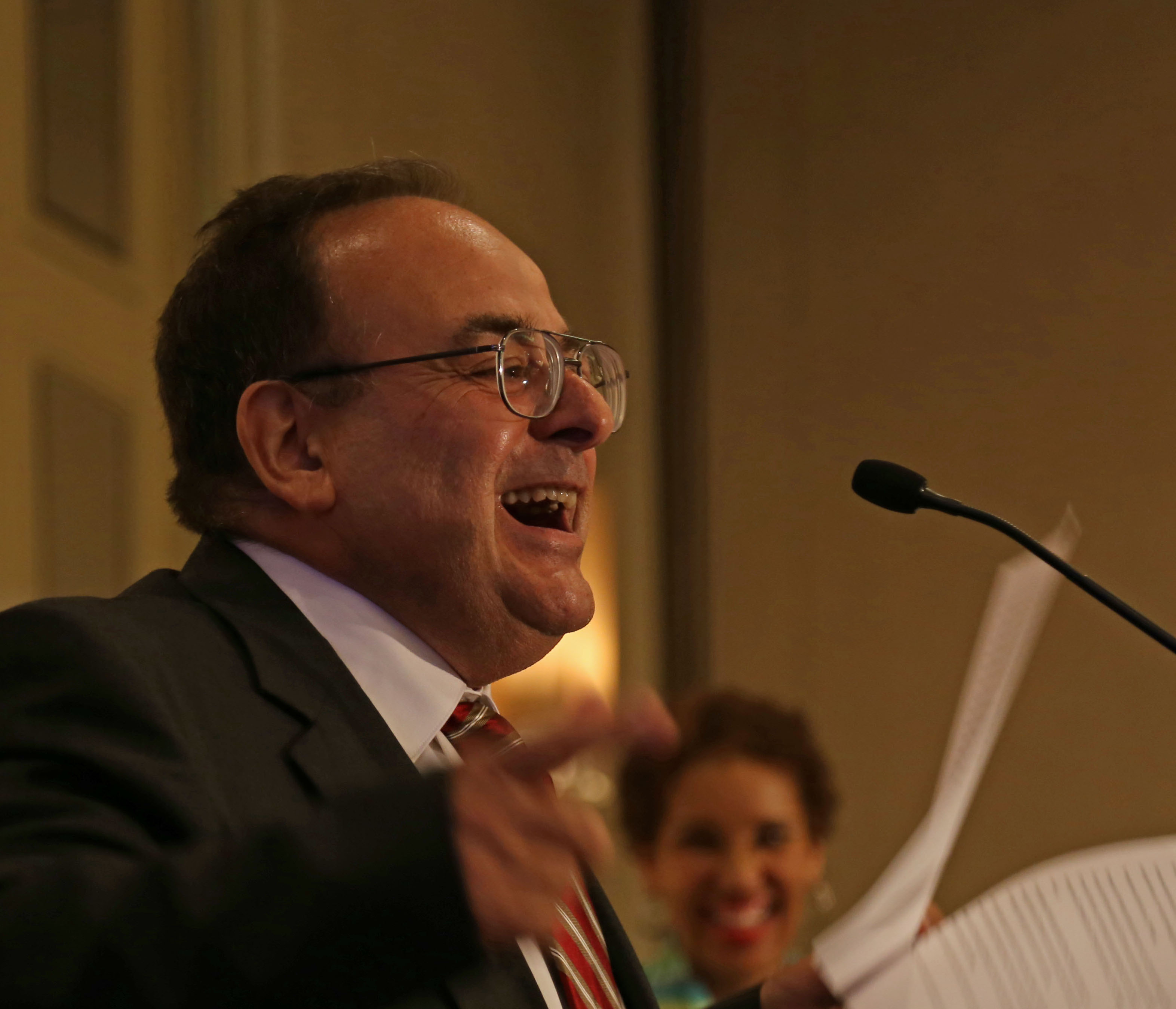
Michael Bugeja, director of the Greenlee School of Journalism and Communication at Iowa State University, accepted on behalf of the Greenlee School the 2014 Equity and Diversity Award presented by the Association for Education in Journalism and Mass Communication on Aug. 6. The award was presented at the keynote session of the annual AEJMC conference in Montreal. Jennifer McGill, AEJMC executive director, said that 14 other schools applied for this award and it was the most competitive year yet. Last year’s winner was Penn State’s
College of Communications. Bugeja gave the following acceptance speech:
Michael Bugeja accepting AEJMC diversity award.Will the faculty and staff of the Greenlee School please rise? This is your award! Please give them a well-deserved round of applause.
I have a few brief remarks.
It has been a long journey for us. Over the past decade, we learned valuable lessons about equity and inclusivity … as well as the meaning of the phrase … “celebrate diversity.”
The operative word, at least for us, is “celebrate.”
That requires a bit of background about diversity. Iowa is one of the most homogenous states in the Union. Consider these statistics: In 2010, there were more white people over the age of 100 in Iowa—846, to be exact—than these under-represented groups who took the ACT: African-Americans, 583; Hispanic/Latino, 700; Asian/Pacific Islanders, 537; and American Indian, 81.
Out-state colleges and universities, especially in Illinois, Minnesota and Nebraska, were competing for this cohort of 1901 prospective minority students. More to the point, so were the 53 colleges and universities in Iowa that could offer in-state tuition.
Each of those institutions had a commitment to celebrate diversity. However, it seemed that everyone was trying to capture a miniscule percentage of that cohort, climate notwithstanding.
The climate I refer to is not the nippy Upper Midwest one, often blamed for lack of diversity. It is the climate in every department, school or college.
Best recruiting practices for diversity may increase numbers of under-represented groups; but climate retains them.
We work on climate every day in Hamilton Hall. Here are some examples associated with doing diversity:
Faculty take Safe Zone training so students know where to go to discuss issues associated with sexual orientation.
Because more than half of our graduate students are from China, we celebrate Lunar New Year with dance, song, food and good will.
Many of our Asian students adopt American names, as is common practice. Several professors at Greenlee adopted Chinese names in response. Mine is Bai Chee Mai.
One advertising professor posts lectures in English and Mandarin, a practice that is gaining national attention and now is spreading throughout the institution.
Two other professors are working on federal grants to help aging female landowners adopt conservation farming practices.
Another has published award-winning works on women pioneers in journalism.
Another professor created a photo documentary of Mexican immigrants in Marshalltown, Iowa, who were subject to the largest-ever raid at a U.S. packing plant.
Four of our students are recent participants in the American Advertising Association’s Promising Minority Student competition.
Uhuru, a student-run multicultural magazine, titled itself after the Swahili word for “freedom” to advertise its mission to under-represented groups.
One of our academic advisers, a member of the Kiowa tribe of Oklahoma, has been selected as one of only 10 advisers across the country to participate in the National Academic Advisers Association’s Emerging Leaders Program.There is so much more to recount. You can find the specifics in our Diversity Page on the front door of the Greenlee website.
Many communication programs can boast similar or even more substantial achievements in equity and diversity. What sets the Greenlee School apart is the ability of faculty and staff to self-critique. It is difficult to self-critique in contentions climates, which is why we focus on the word “celebrate” when we do diversity.
Our philosophy is simple: If you create a welcoming climate, diversity happens.
Some people do not thrive in a celebratory environment. For instance, we do not envy but embrace each other’s successes, as if they were our own. We do not elevate status by title or rank or by touting one type of professional experience, research or degree over another type. We advocate for equity, especially in salary considerations. We expose our students to differing viewpoints that challenge our social and political beliefs, inviting to campus such speakers as Bethany McLean, Vanity Fair; Paul Gidot, Wall Street Journal; Eugene Robinson, Washington Post; and Clarence Page, Chicago Tribune.
As our climate improved, so did our numbers. We raised the percentage of non-white students from 8 percent in 2004 to more than 14 percent today. Greenlee professors have served on college and university diversity committees. Our collective efforts dovetailed nicely into priorities for equity and inclusion advanced by our President, Steven Leath. The focus on climate also has helped facilitate an influx of international undergraduate students to ISU, doubling in five years to almost 2,000 students today. In sum, the practice of global media at Greenlee is helping our institution realize its goal of global diversity and outreach.
Before closing, I’m going to ask the faculty and staff of the Greenlee School to stand once more.
Each one of those colleagues—of various social classes, nationalities, races and orientations—has one thing in common: They put the interests of the School over their own.
I can make that bold statement—each one standing there—shares that requisite attribute of climate. It takes a long journey to get there. If we can do it, so can you.
On behalf of Iowa State University of Science and Technology, home of the iconic George Washington Carver and the first land-grant institution in the nation, we thank all of you in the audience … and the Association for Education in Journalism and Mass Communication … for this high honor and noteworthy recognition.